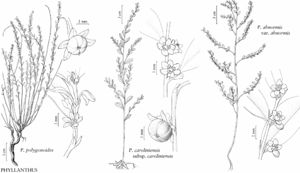Phyllanthus caroliniensis subsp. caroliniensis
Stems usually with 5+ lateral branches, these often branched, glabrous. Leaf-blades: both surfaces glabrous; vein reticulum clearly visible abaxially. Cymules with 1 staminate and (1–) 2–3 (–5) pistillate flowers. Pistillate flowers: sepals linear-lanceolate or narrowly spatulate, (0.7–) 0.8–1 (–1.4) × 0.2–0.3 mm, apex acute; nectary cupular, unlobed, enclosing ovary 1/3–1/2 length at anthesis.
Phenology: Flowering and fruiting summer–fall.
Habitat: Open, moist areas such as stream banks, lake and pond margins, forest openings, depressions in grasslands, disturbed sites.
Elevation: 0–600 m.
Distribution

Ala., Ark., Del., D.C., Fla., Ga., Ill., Ind., Kans., Ky., La., Md., Miss., Mo., N.J., N.C., Ohio, Okla., Pa., S.C., Tenn., Tex., Va., W.Va., Mexico, West Indies, Central America, South America, in se Asia
Discussion
Subspecies caroliniensis is found almost throughout the range of Phyllanthus caroliniensis. In Florida, it reaches its native southern limit in Hillsborough County [it was collected on Key West once in the late nineteenth century (Curtis 185, GH), where it presumably was an introduced waif]. It has also been found as a garden weed in San Diego, California (Rebman 7115, SD), and may become established in that state.
Selected References
None.
Lower Taxa
"elongating" is not a number."/2" is not declared as a valid unit of measurement for this property.
